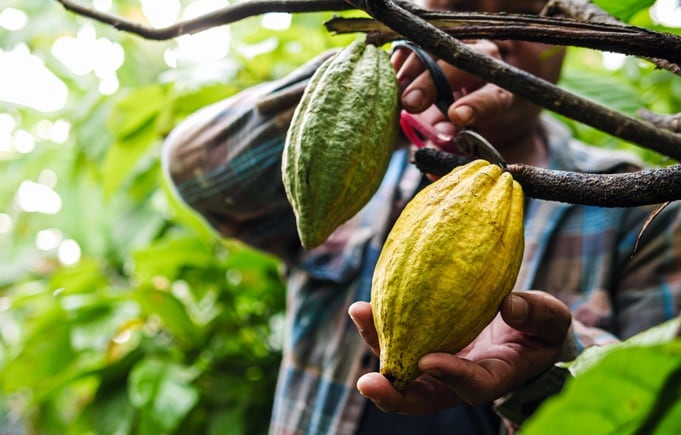Innovative ingredient suppliers showcasing at IFT FIRST in Chicago are answering the desperate call from manufacturers across categories for cocoa replacers and extenders to offset volatile pricing and ensure sufficient supply.
Solutions include fats, flavors and powders ranging from wheat to citrus fiber – all of which offer cost savings as alternatives to cocoa components, have stable supply chains for reliable sourcing and are less vulnerable to the macro-trends contributing to the current crisis, according to ingredient producers.
“Cocoa prices have tripled over the last year, and this is causing big cost management issues,” Amanda Pedersen, product marketing manager at Ardent Mills, told an overflowing crowd of attendees during a session at IFT
She attributed the increase to three major factors: “Disease and climate change, deforestation regulations and geopolitical factors.”
She added these stressors are unlikely to ease in the next three to five years, which means companies need viable long-term solutions – such as Ardent Mill’s Cocoa Replace, which the company debuted at IFT FIRST.
“Cocoa Replace is a very clean label, wheat-based ingredient that we make with a proprietary process, but which is non-GMO and made with US grown and milled wheat,” said Kirk Borchardt, executive chef advisor at Ardent Mills.
He explained Cocoa Replace can substitute for up to 25% of cocoa in many baked goods, but that percentage could go higher if a company was developing new products that did not need to match existing offerings.
An added benefit: Cocoa Replace holds more moisture than cocoa powder so it can improve the moistness of the final product, which Borchardt said helped win over taste testers who said the moist texture and appearance were equivalent – if not slightly higher than the control.
Fiberstar’s neutral tasting Citri-Fi citrus fiber, which is upcycled from the citrus juice industry, also can replace cocoa powder when combined with flavoring agents, said Brock Lundberg, chief science officer at Fiberstar.
He explained that Citri-Fi offers several advantageous properties that can contribute to cocoa replacement systems, including its insoluble fiber, which has different particle sizes. These can be used to create different textures. In addition, Citri-Fi has a high surface area and porosity that binds well with liquids to create flowable powders.
“Citri-Fi does not have a strong cocoa flavor by itself, but it does hold flavors quite well. So, what we have done in some application work is combine a liquid chocolate flavor with Citri-Fi in a one-to-one ratio to make a dry flow powder,” he said.
The system can replace 20% to 50% of cocoa powder “easy,” he said, and while it is harder to replace 100% of cocoa powder, it is possible in some applications.
Smooth like butter: CBEs improve mouthfeel and texture
Other solutions include cocoa butter equivalents, like Shea butter, which AAK showcased in a vegan ice cream at IFT.
Shea “gives good mouthfeel and texture,” and “it has a really great sustainability message attached to it because it is not an industrially farmed crop. It grows in West Africa, falls from the tree, and people pick it up and process it into cooking oil and shea butter,” said Ryan Branch, senior marketing manager at AAK.
He added that shea is starting to be used to replace cocoa butter because it is less expensive. But, he added, the trade off is products sold in the US that use cocoa butter equivalents, like shea, cannot be labeled as chocolate because they do not meet the standards of identity. Therefore, they must be labeled as chocolaty snacks or candy.
In Europe, companies can include up to 5% of shea butter and still label a product as chocolate.
Other fats, like Paragon Pure’s OleBK rice bran butter can replace cocoa butter in softer applications, like a truffle filling, said Jen Tracy, VP sales and marketing, Paragon Pure.
She explained that the plant-based butter is not a one-to-one replacement for cocoa butter, and it has a lower melting point, but it serves well in icings and fillings. In addition, as a palm oil replacement it has lower saturated fat for a healthier nutritional profile.
“It also has a really nice sustainability story because it is a byproduct of rice milling,” Tracy added. “When rice is milled, the husk is taken off and that husk has a lot of fat in it. So, from that, we get this plant-based butter.”
Other pros: It is shelf stable, easy to use, is recognizable to consumers on the nutrition label and can be swapped in on a one-to-one ratio, according to Tracy.
‘If you reduce cocoa with our flavors you have more consistency’
On the flavor front, Prova’s portfolio of flavors featuring a range of brown notes can be used to replace up to 30% cocoa powder while maintaining the original texture and reduce dust around equipment for smoother processing, according to the company.
Using flavors to reduce cocoa also offers enhanced consistency, said Justin Demers, director of applications and product development at Prova.
“Cocoa is an agricultural ingredient. It is a living thing and batch to batch can be slightly different. But our product, our flavors, will always be the same. So, if you reduce cocoa with our flavors you have more consistency,” he explained.
He also noted that it is easier to store as it doesn’t have the same components as cocoa that can oxidize and it doesn’t take up as much space because it is concentrated.
Prova doesn’t just offer ingredients – it offers solutions. With a creation lab in Beverly, Mass., the company can work with companies to create applications with its ingredients, including UHT capabilities to test beverages in high heat processing, added Julie Pickette, marketing manager at Prova.
“When we think about reformulating to replace or reduce cocoa we are not thinking about short-term solutions. If our customers make the leap to change their product, it needs to be a long-term solution,” and so Prova works diligently to ensure its ingredients and applications satisfy manufacturers’ needs, added Demers.
Prinova also seeks to replicate the flavor of cocoa powders, but it takes a “little different approach than some, in that we take each cocoa powder, analyze it for its volatiles, find out what makes that specific cocoa powder tick in terms of color, bitterness – everything – and we create a customized tool for that cocoa powder,” said Alex Amann, a flavorist with Prinova.



